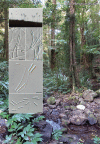Fungal Planet description sheets: 1112-1181
- PMID: 34456379
- PMCID: PMC8375349
- DOI: 10.3767/persoonia.2020.45.10
Fungal Planet description sheets: 1112-1181
Abstract
Novel species of fungi described in this study include those from various countries as follows: Australia, Austroboletus asper on soil, Cylindromonium alloxyli on leaves of Alloxylon pinnatum, Davidhawksworthia quintiniae on leaves of Quintinia sieberi, Exophiala prostantherae on leaves of Prostanthera sp., Lactifluus lactiglaucus on soil, Linteromyces quintiniae (incl. Linteromyces gen. nov.) on leaves of Quintinia sieberi, Lophotrichus medusoides from stem tissue of Citrus garrawayi, Mycena pulchra on soil, Neocalonectria tristaniopsidis (incl. Neocalonectria gen. nov.) and Xyladictyochaeta tristaniopsidis on leaves of Tristaniopsis collina, Parasarocladium tasmanniae on leaves of Tasmannia insipida, Phytophthora aquae-cooljarloo from pond water, Serendipita whamiae as endophyte from roots of Eriochilus cucullatus, Veloboletus limbatus (incl. Veloboletus gen. nov.) on soil. Austria, Cortinarius glaucoelotus on soil. Bulgaria, Suhomyces rilaensis from the gut of Bolitophagus interruptus found on a Polyporus sp. Canada, Cantharellus betularum among leaf litter of Betula, Penicillium saanichii from house dust. Chile, Circinella lampensis on soil, Exophiala embothrii from rhizosphere of Embothrium coccineum. China, Colletotrichum cycadis on leaves of Cycas revoluta. Croatia, Phialocephala melitaea on fallen branch of Pinus halepensis. Czech Republic, Geoglossum jirinae on soil, Pyrenochaetopsis rajhradensis from dead wood of Buxus sempervirens. Dominican Republic, Amanita domingensis on litter of deciduous wood, Melanoleuca dominicana on forest litter. France, Crinipellis nigrolamellata (Martinique) on leaves of Pisonia fragrans, Talaromyces pulveris from bore dust of Xestobium rufovillosum infesting floorboards. French Guiana, Hypoxylon hepaticolor on dead corticated branch. Great Britain, Inocybe ionolepis on soil. India, Cortinarius indopurpurascens among leaf litter of Quercus leucotrichophora. Iran, Pseudopyricularia javanii on infected leaves of Cyperus sp., Xenomonodictys iranica (incl. Xenomonodictys gen. nov.) on wood of Fagus orientalis. Italy, Penicillium vallebormidaense from compost. Namibia, Alternaria mirabibensis on plant litter, Curvularia moringae and Moringomyces phantasmae (incl. Moringomyces gen. nov.) on leaves and flowers of Moringa ovalifolia, Gobabebomyces vachelliae (incl. Gobabebomyces gen. nov.) on leaves of Vachellia erioloba, Preussia procaviae on dung of Procavia capensis. Pakistan, Russula shawarensis from soil on forest floor. Russia, Cyberlindnera dauci from Daucus carota. South Africa, Acremonium behniae on leaves of Behnia reticulata, Dothiora aloidendri and Hantamomyces aloidendri (incl. Hantamomyces gen. nov.) on leaves of Aloidendron dichotomum, Endoconidioma euphorbiae on leaves of Euphorbia mauritanica, Eucasphaeria proteae on leaves of Protea neriifolia, Exophiala mali from inner fruit tissue of Malus sp., Graminopassalora geissorhizae on leaves of Geissorhiza splendidissima, Neocamarosporium leipoldtiae on leaves of Leipoldtia schultzii, Neocladosporium osteospermi on leaf spots of Osteospermum moniliferum, Neometulocladosporiella seifertii on leaves of Combretum caffrum, Paramyrothecium pituitipietianum on stems of Grielum humifusum, Phytopythium paucipapillatum from roots of Vitis sp., Stemphylium carpobroti and Verrucocladosporium carpobroti on leaves of Carpobrotus quadrifolius, Suttonomyces cephalophylli on leaves of Cephalophyllum pilansii. Sweden, Coprinopsis rubra on cow dung, Elaphomyces nemoreus from deciduous woodlands. Spain, Polyscytalum pini-canariensis on needles of Pinus canariensis, Pseudosubramaniomyces septatus from stream sediment, Tuber lusitanicum on soil under Quercus suber. Thailand, Tolypocladium flavonigrum on Elaphomyces sp. USA, Chaetothyrina spondiadis on fruits of Spondias mombin, Gymnascella minnisii from bat guano, Juncomyces patwiniorum on culms of Juncus effusus, Moelleriella puertoricoensis on scale insect, Neodothiora populina (incl. Neodothiora gen. nov.) on stem cankers of Populus tremuloides, Pseudogymnoascus palmeri from cave sediment. Vietnam, Cyphellophora vietnamensis on leaf litter, Tylopilus subotsuensis on soil in montane evergreen broadleaf forest. Morphological and culture characteristics are supported by DNA barcodes.
Keywords: ITS nrDNA barcodes; LSU; new taxa; systematics.
© 2020 Naturalis Biodiversity Center & Westerdijk Fungal Biodiversity Institute.
Figures











































































































References
-
- Antonín V, Ryoo R, Ka K-H, et al. . 2014. Three new species of Crinipellis and one new variety of Moniliophthora (Basidiomycota, Marasmiaceae) described from the Republic of Korea. Phytotaxa 170: 86–102.
-
- Arauzo S, Iglesias P.2014. La familia Geoglossaceae ss. str. en la península Ibérica y la Macaronesia. Errotari 11: 166–259.
-
- Attili-Angelis D, Duarte APM, Pagnocca FC, et al. . 2014. Novel Phialophora species from leaf-cutting ants (tribe Attini). Fungal Diversity 65: 65–75.
-
- Australian Plant Pest Database, online database, (accessed 06 August 2020). https://appd.ala.org.au/appd-hub/search#tab_simpleSearch.
LinkOut - more resources
Full Text Sources
